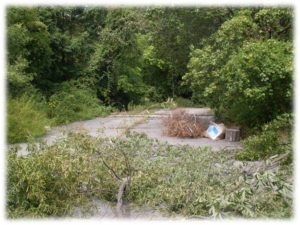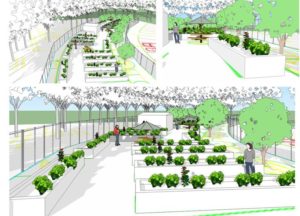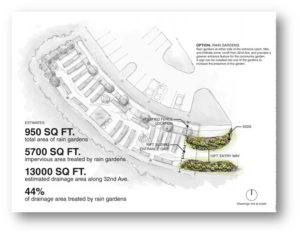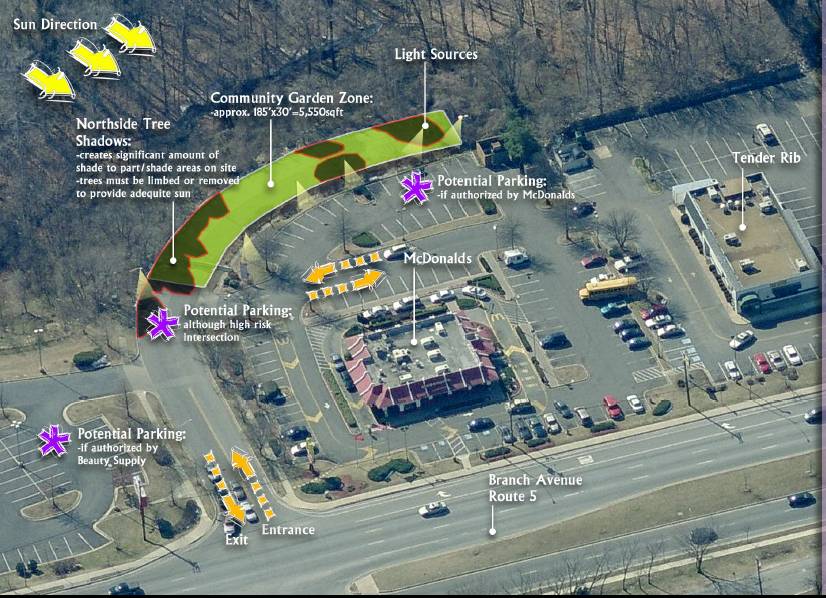 Located on 32nd and Branch Ave in Temple Hills, MD is a 5,000 square foot abandoned street scape project that has existed since 1974. Thirty years later this forgotten site, a road that literally led nowhere, will be the future home for an urban farm thanks to an initiative spearheaded by Branch Avenue In Bloom (BAIB). Since 2010 BAIB, a program of the Maryland Small Business Development Center, has been coordinating with the local businesses and community residents to revitalize the Branch Avenue commercial corridor. BAIB has partnered with the Alice Ferguson Foundation’s Trash Free Potomac Watershed Initiative to address litter in their community with the Regional Litter Prevention Campaign and through community cleanups.
Located on 32nd and Branch Ave in Temple Hills, MD is a 5,000 square foot abandoned street scape project that has existed since 1974. Thirty years later this forgotten site, a road that literally led nowhere, will be the future home for an urban farm thanks to an initiative spearheaded by Branch Avenue In Bloom (BAIB). Since 2010 BAIB, a program of the Maryland Small Business Development Center, has been coordinating with the local businesses and community residents to revitalize the Branch Avenue commercial corridor. BAIB has partnered with the Alice Ferguson Foundation’s Trash Free Potomac Watershed Initiative to address litter in their community with the Regional Litter Prevention Campaign and through community cleanups.
 The urban farm will have 20 raised beds where participants will have the freedom to plant crops of their choice as well as have over 20 fruit trees, including peach, plum, pomegranate, fig, and persimmon. The farm will give the local community an opportunity to grow their own food and eat healthier. This is especially important in the Branch Avenue corridor, which is considered a food desert, an area where there aren’t any grocery stores nearby. The farm will also serve as a shared community space that will feature urban farming entrepreneurial training, stormwater management awareness, hands on educational opportunities for area schools, jazz shows, movies, and other related outdoor activities. We can’t wait to see how the urban farm will impact and empower the local community.
The urban farm will have 20 raised beds where participants will have the freedom to plant crops of their choice as well as have over 20 fruit trees, including peach, plum, pomegranate, fig, and persimmon. The farm will give the local community an opportunity to grow their own food and eat healthier. This is especially important in the Branch Avenue corridor, which is considered a food desert, an area where there aren’t any grocery stores nearby. The farm will also serve as a shared community space that will feature urban farming entrepreneurial training, stormwater management awareness, hands on educational opportunities for area schools, jazz shows, movies, and other related outdoor activities. We can’t wait to see how the urban farm will impact and empower the local community.
 What originally started off as an idea incepted in 2011 to transform the physical appearance of Branch Avenue, has since transformed into a project that affects the public health and environmental spectrums of the local area and the state. In 2012 BAIB discovered that stormwater runs off the site into a local stream, Oxon Run, which is behind the farm. This stormwater runoff carries pollutants, such as litter and nitrogen, which contaminate Oxon Run. BAIB decided to incorporate stormwater management strategies into their schematics to address the problem. As Oxon Run empties into the Potomac River and ultimately the Chesapeake Bay, the urban farm will not only help to build community, revitalize the business corridor, and address a food desert, but will work to protect our environment and the region’s waterways.
What originally started off as an idea incepted in 2011 to transform the physical appearance of Branch Avenue, has since transformed into a project that affects the public health and environmental spectrums of the local area and the state. In 2012 BAIB discovered that stormwater runs off the site into a local stream, Oxon Run, which is behind the farm. This stormwater runoff carries pollutants, such as litter and nitrogen, which contaminate Oxon Run. BAIB decided to incorporate stormwater management strategies into their schematics to address the problem. As Oxon Run empties into the Potomac River and ultimately the Chesapeake Bay, the urban farm will not only help to build community, revitalize the business corridor, and address a food desert, but will work to protect our environment and the region’s waterways.
To follow the progress of the Branch Avenue Urban Farm, please visit the www.branchavenueinbloom.org. If you have any questions, BAIB can be reached at baibinfo@umd.edu and/or (301)-702-2250.
To learn more about where your stormwater goes, explore this map of bags of trash collected at community cleanups in the Washington, DC area. If you zoom into your location, you can use the “Flow Path Tool” to figure out where your stormwater goes and the “Upstream Area Tool” to figure out what areas drain towards you. Both these tools are under the “Draw Tools” menu listed on the right of the map.


